Source: Glassnode; Compiled by: Baishui, Golden Finance
Summary
Bitcoin has entered a correction phase, trading 11% below its all-time high of $108,000, but remains above key support levels, maintaining a constructive market structure.
Z-Score analysis shows that cyclical highs are often consistent with various indicators that are 1.5 to 2.0σ above the average, providing a framework to help navigate bullish market phases.
The current price of Bitcoin is about 10% above the cost basis of $884,000 for short-term holders, highlighting the downside risk if momentum stalls and prices fall below this level.
Unrealized losses are concentrated among short-term holders, with 2.0-3.5 million BTC held, reflecting moderate market pressure.
Relative unrealized losses peaked at 4.3% in Q3 2024, significantly lower than previous cycles driven by external shocks, highlighting a more spot-oriented and patient market.
Peak of Change
The realized price reflects the average price of all Bitcoins last traded on-chain, and therefore represents the total cost basis of the market. The MVRV ratio is the ratio between spot price and realized price, and it measures the size of the average unrealized profit. Values above 1 indicate average unrealized profits, while values below 1 indicate unrealized losses.
The MVRV ratio is currently trading at 1.32, indicating that the average unit of BTC holds 32% in unrealized profits. This structure is similar to the one after the ATH in mid-April 2024, indicating that overall sentiment remains positive despite the market correction.
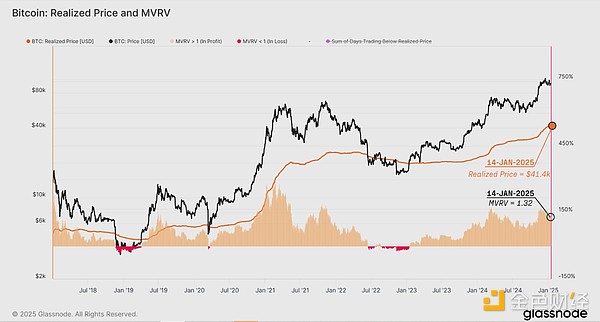
Over the years, the Bitcoin market has matured, and at the same time, the peaks in MVRV have periodically decayed near cyclical tops. This reflects the overall weakening of speculative extremes as the asset size grows.
The MVRV highs in each market cycle have been gradually lower, indicating that the average unrealized profit multiple is decreasing:
2011: 8.07x
2014: 6.00x
2018: 4.81x
2021: 3.98x
2024: 2.78x (to date)
This decline suggests that volatility and speculative intensity are gradually decreasing as market size and liquidity grow. This also shows that, although Bitcoin is still cyclical, each peak has become relatively less exaggerated, consistent with a more mature and efficient market structure.

To explain the reduction in MVRV peaks in consecutive cycles, we can use statistical methods to normalize its oscillation range. A widely accepted method in financial time series analysis is the Z-score, which is calculated as follows:
Z-Score = (X - μ) / σ
When calculating the Z-score, we can use the entire historical data set for a cumulative view or we can use a shorter rolling window to better capture the dynamic nature of financial cycles and the gradually decreasing peaks in MVRV.
Using the entire historical data for the MVRV Z-score transformation may lead to some distorted results because earlier cycles with higher peaks will distort the mean and standard deviation and make them not reflect the current market conditions.
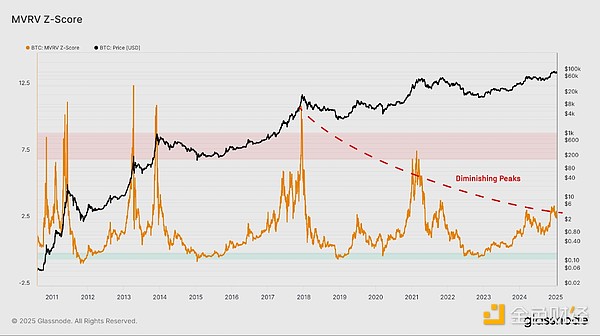
Therefore, to account for these effects, we optimize the rolling window by shortening its length and using more recent market history as a benchmark.
The figure below compares the cumulative Z-score with a version calculated using a 4-year rolling window. Although we try to accommodate the dynamic nature of market cycles, the results remain nearly identical and the MVRV peak decay issue remains unresolved.
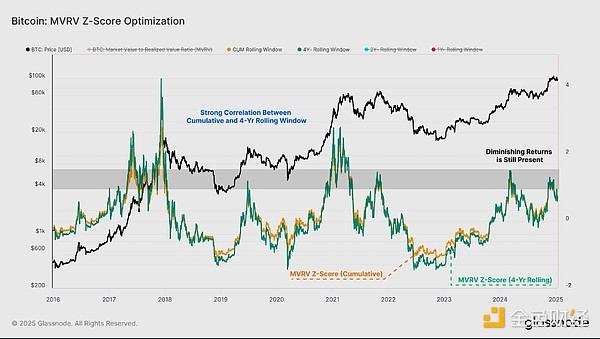
Moving to the 2-year rolling window for the Z-score calculation (blue), the peak observed in the most recent cycle ATH in March 2024 is very close to the range of peaks in the previous two cycles.
In this case, we have now adjusted for the decline in the MVRV peak. However, the 2-year rolling window Z-score does not mark the significant market highs in Q4 2015, Q3 2019, and Q2 2023, suggesting that there may be potential for further optimization.
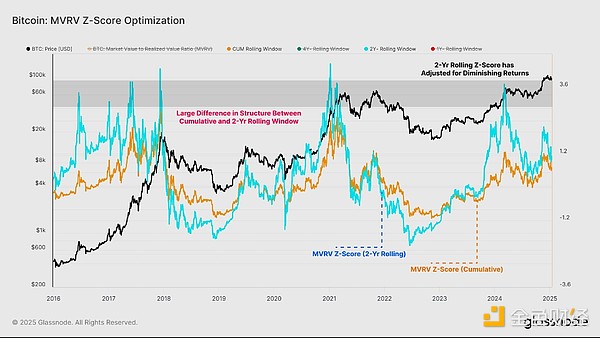
Finally, we applied a 1-year rolling window in the Z-score calculation, which resulted in a more precise and promising transformation. This approach can identify mid- and late-stage peaks on a similar scale, providing a clearer representation of recent market dynamics.
This 1-year MVRV Z-score suggests that cyclical bull markets consistently reach local and global peaks within 2σ, with investor profitability increasing significantly in a relatively short period of time. In the bear market phase, local and global lows are captured when MVRV trades -1.5σ away from the mean.
This improved MVRV Z-score can provide a more responsive framework to identify key market turning points throughout the cycle and help adjust for overall peak declines near extremes.
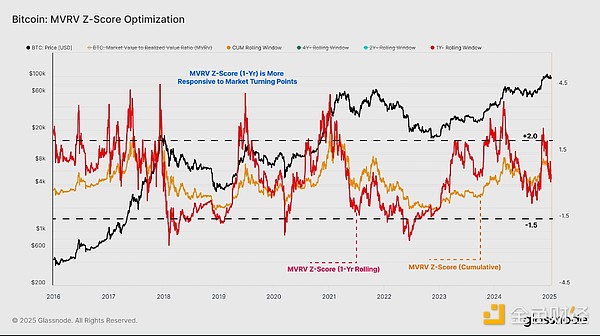
Now that we have optimized the rolling window to 1 year, we can extend this framework to back-calculate the threshold price levels that define these recent peaks and troughs.
Bull markets are characterized by prices trading between the 1-year average, with peaks above around 2σ. Conversely, bear market prices remain below the average, with significant lows occurring around -1.5σ. This structured approach allows for a clearer demarcation of market phases.
Currently, Bitcoin is trading at $94,398, above the 1-year average of $909K but below the +2σ threshold of $1.126K. This suggests that the market is still in a bullish phase, although it has retreated slightly from its recent highs, when it was above the upper limit.
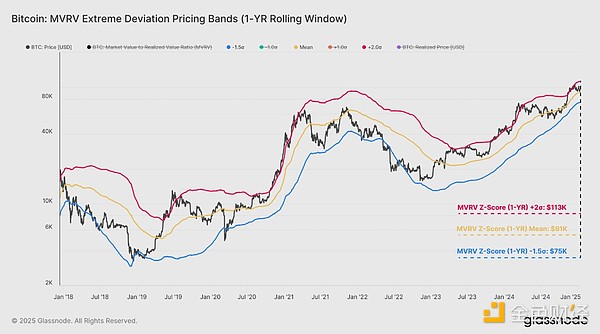
Assessing the Revision
The 1-year MVRV Z-score model shows that the market has cooled off from its strong rally, and we can now assess investor profitability by measuring unrealized losses on holdings. This helps gauge the incentives of market participants and identify key risk areas to focus on.
First, by analyzing the physical adjusted cost basis distribution of the circulating supply, it is clear that all unrealized losses are concentrated on short-term holders - investors who purchased tokens within the past 155 days (close to the market peak).
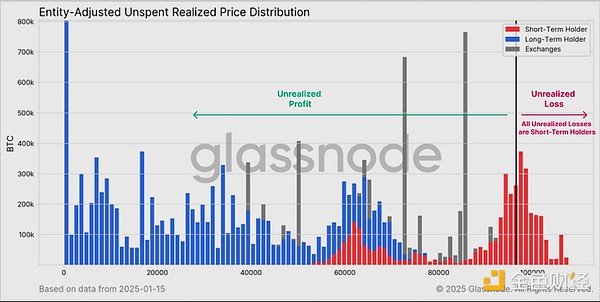
By focusing on the pressure from short-term holders as potential sellers, we can look for areas where unrealized losses could become severe if the current market decline intensifies.
The average cost basis for short-term holders is currently $884,000. Based on similar statistical methods as above, we also show a range of highs ($1.255 million) and lows ($685,000) representing typical extremes of price action during bull and bear markets.
The spot price is currently 9.2% above the cost basis of short-term holders, indicating that the market is still in the norm of a typical bull market. However, if the market fails to resume upward momentum, a break below the STH cost basis becomes more likely, which could lead to short-term pressure and additional selling if investors begin to panic.
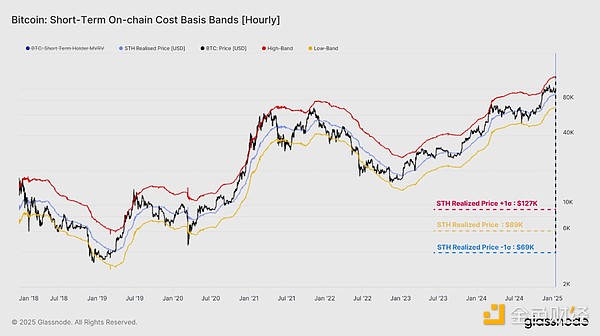
To better gauge the degree of pressure being experienced, we can assess the current supply of BTC in a state of unrealized loss. From a historical perspective, over the past 10 years, we can observe that:
During bull markets, the number of BTC in the red has typically remained below 4 million.
In the early stages of the bear market, the number of lost BTC reached 4 million to 8 million.
This week, market volatility resulted in the loss of 2 million to 3.5 million BTC. Although the losses are huge, this range is still lower than the 4 million BTC lost during the local market lows between July and September 2024. This suggests that the current market may be in a more depressed state than the previous adjustment phase. Another dimension to measure the pain of the market is the relative unrealized loss indicator, which measures the ratio of unrealized losses (in US dollars) to market value. Looking back at the recent cycle, it is possible to find similarities between the current market and the 2016-17 bull run.
Unlike the 2019-22 cycle, where external shocks such as the COVID-19 pandemic pushed relative unrealized losses to levels above 10%, the consolidation phase in the third quarter of 2024 only pushes this indicator to about 4.3%.
Arguably, the current market cycle has experienced less stress, likely due to smaller drawdowns, lower volatility, and new spot demand through ETFs and institutional investors.
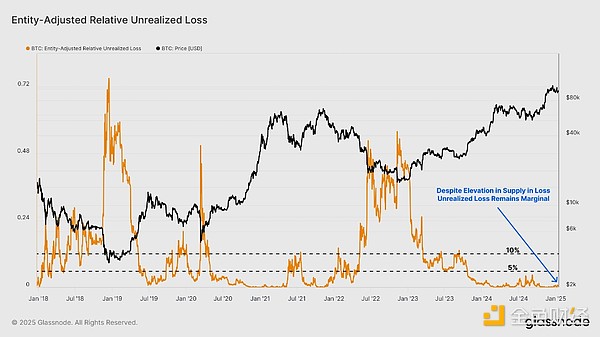
Conclusion
Bitcoin has entered a correction phase, trading 11.1% below its all-time high of $108,000. However, the spot price is still trading above several key support levels, suggesting that the current bullish market structure remains intact. The market distress is relatively mild, as measured by the historically small unrealized losses held by market participants, which exacerbates the situation.
We also show how the MVRV z-score optimized using a 1-year rolling window can provide a framework to navigate recent bullish and bearish market phases. According to this model, we remain in bullish territory, although the cost basis for short-term holders remains at $88.4K, a critical level to maintain constructive sentiment.
 Brian
Brian
 Brian
Brian Weiliang
Weiliang Joy
Joy Miyuki
Miyuki Joy
Joy Alex
Alex Joy
Joy Brian
Brian Weiliang
Weiliang Miyuki
Miyuki